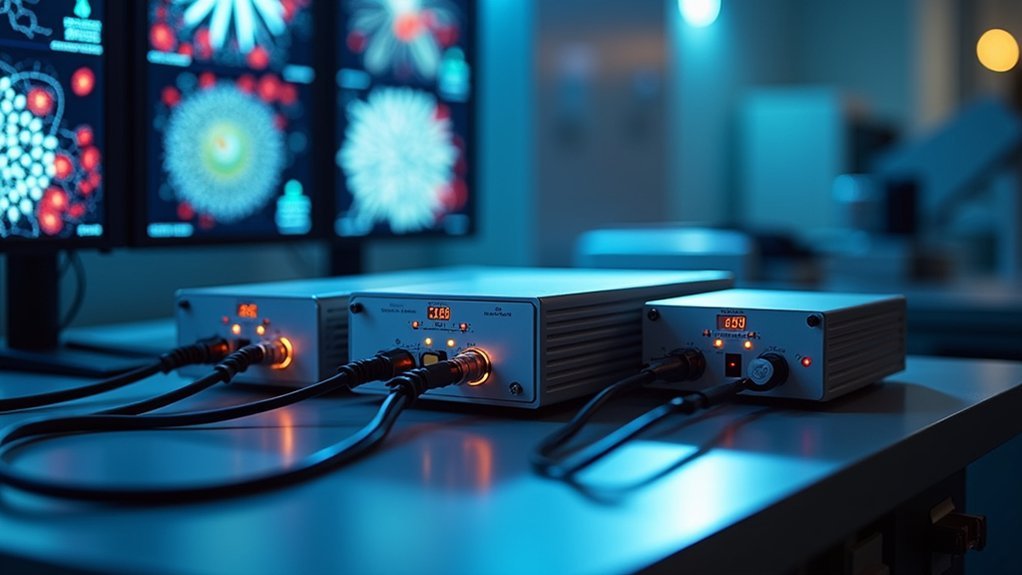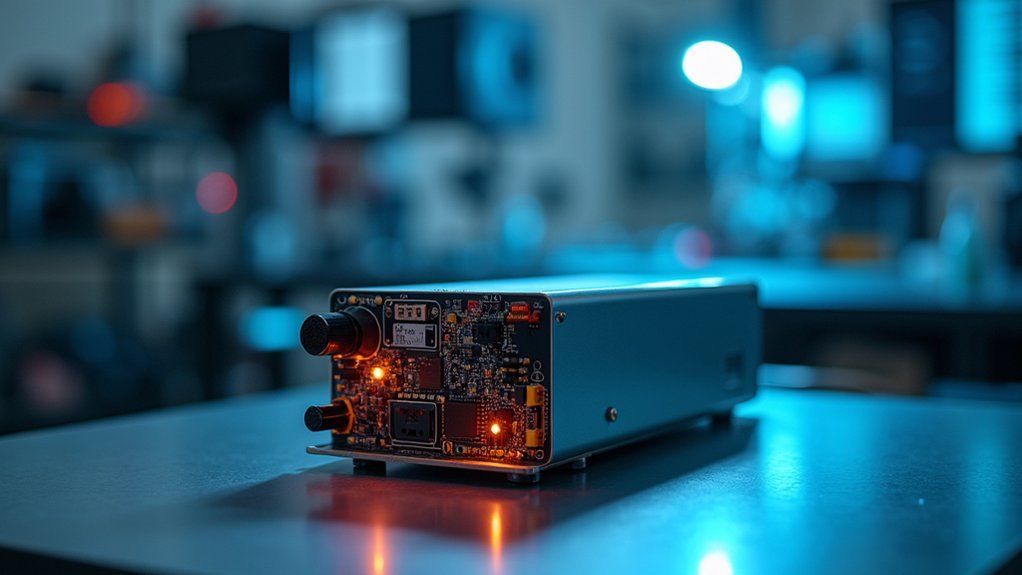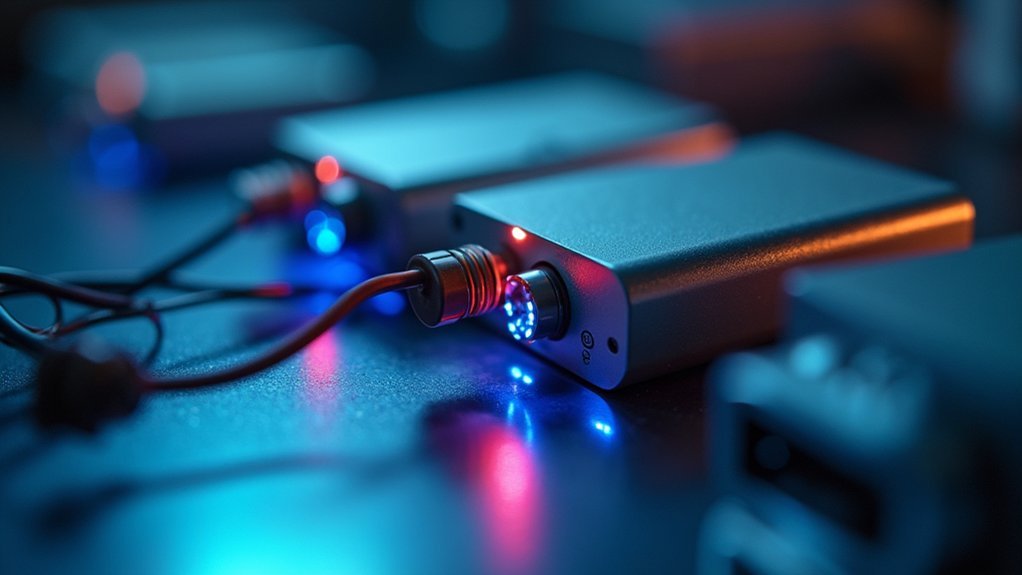Photo micrography requires stable power supplies to guarantee consistent illumination and high-quality images. For research microscopes, you’ll need 6-12V DC systems with proper voltage regulation to prevent fluctuations. LED setups (12-24V) offer flicker-free imaging while halogen and xenon sources demand dedicated power management for their high temperatures. Consider battery packs with lithium-ion technology for field work, and don’t overlook heat dissipation systems for equipment longevity. The right power solution can dramatically elevate your microscopic imaging results.
Understanding Power Requirements for Microscope Illumination

The cornerstone of effective photo micrography lies in proper illumination. When setting up your microscope lighting system, you’ll need to understand the specific power requirements of your equipment. Most microscope illumination systems utilize tungsten-halogen bulbs operating on 12 volts DC, generating up to 100 watts with color temperatures ranging from 2200 K to 3400 K.
Your lighting equipment choices dictate the power supplies needed. External illumination sources typically require 6-12 volt DC conversion from standard 120 volt outlets.
For microscopes without built-in lighting, you’ll need appropriate power supplies that can deliver stable DC power at the correct voltage. This stability is essential for consistent imaging results, especially when capturing high-magnification specimens where even minor illumination fluctuations can greatly impact image quality.
LED Power Supply Systems for Modern Photo Micrography
As microscopy technology evolves, LED illumination systems have emerged as superior alternatives to traditional tungsten-halogen sources. These systems operate on specialized LED power supply systems that deliver consistent 12V to 24V output, ensuring your imaging sessions remain flicker-free.
LED illumination represents the new gold standard in microscopy, delivering flicker-free imaging with precise voltage control.
You’ll find most high-quality setups incorporate constant current drivers that maintain stable brightness regardless of minor voltage fluctuations. This stability is essential for capturing precise microscopic details.
Modern systems offer color temperature adjustments, allowing you to optimize lighting conditions for specific specimens or imaging techniques.
The compact design of today’s LED supplies makes your workspace more efficient while their low heat emission protects both optical components and specimens.
With dimming capabilities and reliable performance, these power systems represent the ideal balance of functionality and convenience for your photo micrography endeavors.
Halogen and Xenon Light Source Power Management

While LED systems represent the cutting edge, many microscopy laboratories still rely on traditional halogen and xenon illumination sources for their specific spectral advantages.
Halogen lamps operate at high temperatures (2700-3350K) and require dedicated power supplies that convert standard voltages to 6-12 volts DC for stable operation.
Your xenon arc lamps deliver continuous, evenly distributed light across the visible spectrum, making them ideal for applications requiring precise color balance.
However, both light sources demand careful power management to maximize their operational lifespan of 1000-2500 hours for halogens.
You’ll need well-ventilated lamphouses and should minimize frequent on-off switching, which greatly reduces lamp life and alters spectral output.
Proper power management not only guarantees consistent illumination but also addresses safety concerns inherent to these high-temperature lighting systems.
Battery-Powered Solutions for Field Microscopy
When venturing into field microscopy, you’ll need reliable portable power packs that deliver consistent voltage for your lighting equipment without adding excessive weight to your kit.
Various rechargeable battery options exist, from lithium-ion packs specifically designed for microscope illumination to adapted camera batteries with appropriate voltage converters.
For extended expeditions away from conventional power sources, compact solar charging systems can keep your batteries replenished, ensuring continuous operation even in remote locations.
Portable Power Packs
Field microscopy demands reliable power solutions that won’t leave you stranded in remote locations. Portable power packs like the Moman Power 99 v mount battery offer multiple charging ports to simultaneously power your cameras, flashes, and microscope displays during outdoor sessions.
High-capacity portable power packs are essential when using high-power lighting setups for extended periods. You’ll find compact battery packs particularly valuable for portable lights, providing the flexibility needed while moving between field sites without sacrificing power output.
To maximize versatility, invest in adapter cables and battery adapter plates that guarantee compatibility across your various lighting accessories.
Don’t overlook maintenance—proper care of your battery packs, including protection from moisture and physical damage, will greatly extend their lifespan and guarantee reliable performance during critical microscopy sessions.
Rechargeable Battery Options
Three reliable rechargeable battery options stand out for field microscopy applications. High-capacity rechargeable battery packs provide the necessary power output for studio strobes and portable lighting setups, ensuring your specimens are properly illuminated wherever you work.
V-mount batteries offer versatility with multiple powering options, efficiently running your cameras, flashes, and other equipment simultaneously.
When selecting your power solution, you’ll need to take into account voltage compatibility and available input/output ports. Compact models deliver excellent mobility for outdoor sessions where traditional power isn’t accessible.
Gold-mount alternatives provide similar benefits to V-mount batteries with different connection systems.
Don’t overlook maintenance requirements—regular charging checks and safe operation practices will maximize your battery’s performance and lifespan during field photography sessions.
Solar Charging Systems
Since traditional power sources are often unavailable in remote research locations, solar charging systems have become indispensable for field microscopy work. These sustainable solutions convert sunlight into electricity, charging high-capacity battery packs that power your microscopes and lighting equipment.
When selecting a system for photomicrography, you’ll need to evaluate the power capacity of the battery pack against your equipment requirements. Look for battery packs with multiple output ports and compatible voltage options to support various devices simultaneously.
The efficiency of your solar panels directly impacts charging time, so choose panels appropriate for the sunlight conditions in your study area.
You’ll benefit from the portability and eco-friendly nature of solar charging systems, reducing your carbon footprint while conducting research in even the most isolated environments.
Voltage Regulators and Stabilization Technologies
Reliable voltage regulation forms the backbone of effective photo micrography lighting systems. You’ll find that voltage regulators prevent fluctuations that could otherwise compromise your image quality and damage sensitive equipment. When selecting a power supply for your setup, prioritize models with built-in regulation to protect against surges and extend equipment lifespan.
Pure sine wave stabilization technologies deliver clean voltage outputs that mimic household electricity, reducing audible noise in your studio lights and ensuring consistent performance. These technologies give you precise control over illumination—critical for capturing high-quality micrographs with accurate color representation.
| Stabilization Type | Benefits | Impact on Images |
|---|---|---|
| Pure Sine Wave | Noiseless operation | Truer colors |
| Line Conditioners | Surge protection | Consistent exposure |
| Digital Voltage Control | Precise adjustments | Sharper details |
| UPS Systems | Backup power | Uninterrupted sessions |
| Isolation Transformers | EMI reduction | Cleaner backgrounds |
Heat Dissipation and Safety Considerations

Heat management represents a fundamental aspect of photo micrography lighting systems that directly impacts both image quality and equipment longevity. Your tungsten-halogen lamps require proper heat dissipation through well-designed lamphouses with integrated heat sinks to maintain stable performance and extend bulb life.
Don’t restart high-temperature lamps immediately after shutdown—allow sufficient cooling time to prevent thermal shock.
When working with your lighting equipment, follow these safety precautions:
- Avoid direct observation of mercury and xenon lamps due to explosion hazards
- Use appropriate protective gear when operating high-temperature light sources
- Allow proper ventilation around all lamp housings to prevent overheating
Regularly inspect your system for electrical faults by checking cables, connections, and fuses.
This preventive maintenance helps avoid equipment damage and guarantees consistent illumination for your microscopy work.
Specialized Power Adapters for Research-Grade Microscopes
Professional photo micrography demands precision power supply solutions tailored specifically for research-grade microscopes.
You’ll find that most research microscopes operate on 6-12 volt DC systems, requiring external power supplies to convert standard AC voltage to appropriate levels for ideal illumination control.
When working with tungsten-halogen lamps, you’ll need dedicated adapters designed for their specific voltage requirements to maintain consistent brightness and color temperature.
These specialized adapters often include voltage regulators that stabilize power delivery, protecting sensitive lighting components from harmful fluctuations.
Advanced voltage regulation ensures microscope component longevity by shielding sensitive illumination systems from power fluctuation damage.
For advanced setups, consider external illumination sources with power adapters featuring diffusers and filters.
These guarantee even light distribution and proper color balance in your micrographs.
While battery options exist, a reliable external power supply delivers the consistent lighting power necessary for professional-quality photo micrography results.
Frequently Asked Questions
How Often Should LED Illumination Systems Be Recalibrated?
You should recalibrate LED illumination systems annually or after 500 hours of use. If you notice color shifts or intensity changes, don’t wait—recalibrate immediately to maintain accurate results and peak performance.
Can Household Power Conditioners Improve Microscope Lighting Quality?
Yes, household power conditioners can improve your microscope lighting quality by filtering electrical noise and providing stable voltage. They’ll eliminate flickering and inconsistent illumination that might compromise your imaging results and observations.
What Wireless Control Options Exist for Remote Microscopy Lighting Adjustment?
You can remotely adjust microscope lighting using Bluetooth controllers, WiFi-enabled systems, infrared remotes, or smartphone apps. These wireless options let you fine-tune illumination without disturbing your specimen or disrupting your imaging workflow.
How Do Electromagnetic Fields From Power Supplies Affect Sensitive Specimens?
Electromagnetic fields from power supplies can damage sensitive specimens by altering cellular structures and biochemical processes. You’ll need shielded supplies or increased distance between specimens and power sources to minimize these harmful effects.
Are Retrofit Power Solutions Available for Older Microscope Models?
Yes, you’ll find retrofit power solutions for older microscope models. Many manufacturers offer upgrade kits that replace outdated power supplies with modern, compatible alternatives that improve performance while maintaining your existing optical system’s functionality.
In Summary
When you’re selecting lighting power supplies for photo micrography, you’ll need to carefully match your microscope’s technical requirements with the right solution. Whether you’ve chosen LED, halogen, or xenon illumination, proper power management guarantees peak image quality and equipment longevity. Don’t overlook temperature control and voltage stabilization features. For field work, consider battery options that balance portability with performance to capture the perfect microscopic images wherever your research takes you.





Leave a Reply